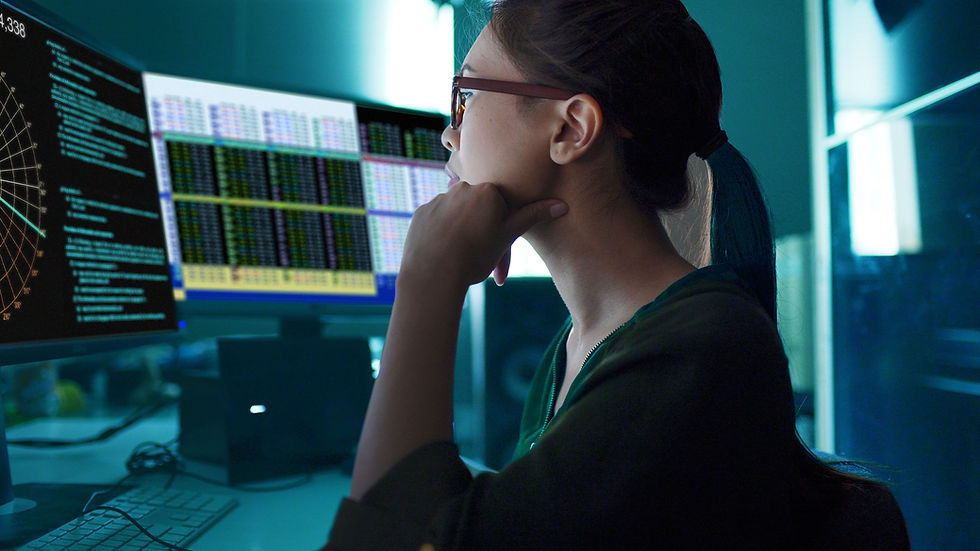Lighting for Telehealth: Creating a Professional and Inviting Atmosphere
- David Larsen
- Jul 9, 2024
- 7 min read

Vol. 1, No. 16 | July 9, 2024 | By Dave Larsen, Väsentlig Consulting LLC
As a home-based solo mental health practitioner using telehealth as your primary method of interacting with clients, the quality of your video lighting plays a crucial role in creating a professional and inviting atmosphere for your virtual sessions (Gough & Rosenfeld, 2019).
Poor lighting can not only make it difficult for your clients to see and connect with you but can also convey a lack of professionalism and attention to detail (Doarn et al., 2018).
In this post, we'll explore the key principles and strategies for optimizing your telehealth lighting setup, drawing on research and best practices in the field.
The Importance of Lighting in Telehealth
Lighting is a critical component of effective video communication, and this is particularly true in the context of telehealth (Fatehi et al., 2021). Good lighting can help to:
Enhance Visibility: Proper lighting ensures that your face is clearly visible to your clients, allowing them to pick up on important non-verbal cues and facial expressions (Doarn et al., 2018).
Convey Professionalism: A well-lit video conveys a sense of professionalism and attention to detail, helping to build trust and credibility with your clients (Gough & Rosenfeld, 2019).
Create a Welcoming Atmosphere: Warm, inviting lighting can help to create a comfortable and welcoming atmosphere for your clients, even in a virtual setting (Fatehi et al., 2021).
Reduce Eye Strain: Poor lighting can cause eye strain and fatigue for both you and your clients, making it difficult to maintain focus and engagement during long sessions (Doarn et al., 2018).
By investing in a high-quality lighting setup, telehealth practitioners can enhance the effectiveness and professionalism of their virtual sessions, leading to better outcomes and client satisfaction (Gough & Rosenfeld, 2019).
Key Principles of Telehealth Lighting
To create a professional and inviting lighting setup for your telehealth sessions, there are several key principles to keep in mind, including:
Brightness: Your lighting should be bright enough to clearly illuminate your face and eliminate shadows, but not so bright that it causes glare or washes out your features (Fatehi et al., 2021). A good rule of thumb is to aim for a light level that is similar to what you would experience in a well-lit office or therapy room.
Color Temperature: The color temperature of your lighting can have a significant impact on the mood and atmosphere of your video (Doarn et al., 2018). Warmer color temperatures (around 2700-3000K) create a cozy and inviting feel, while cooler temperatures (around 5000-6500K) convey a more professional and clinical atmosphere. For most telehealth sessions, a neutral color temperature (around 4000K) is recommended.
Positioning: The positioning of your lighting is just as important as the brightness and color temperature (Gough & Rosenfeld, 2019). Ideally, your main light source should be positioned directly in front of you, slightly above eye level, to illuminate your face evenly and eliminate shadows. You may also want to use additional lights to the sides or behind you to create depth and separation from your background.
Diffusion: Harsh, direct lighting can create unflattering shadows and highlights on your face, while soft, diffused lighting creates a more natural and inviting appearance (Fatehi et al., 2021). You can achieve diffused lighting by using a softbox, umbrella, or other diffusion materials to soften and spread the light from your sources.
Consistency: To maintain a professional and cohesive appearance across sessions, it's important to use consistent lighting setups and settings (Doarn et al., 2018). This may involve using the same light sources, positions, and settings for each session, or creating a standardized lighting protocol that you can easily replicate.
By keeping these principles in mind, telehealth practitioners can create a lighting setup that enhances the quality and professionalism of their virtual sessions (Gough & Rosenfeld, 2019).
Types of Lighting for Telehealth
There are several types of lighting that telehealth practitioners can use to create a professional and inviting atmosphere for their virtual sessions, including:
Ring Lights: Ring lights are a popular choice for telehealth practitioners due to their ease of use and portability (Fatehi et al., 2021). These circular lights provide even, diffused lighting that eliminates shadows and creates a flattering appearance. Ring lights are available in a range of sizes and color temperatures and can be easily mounted on a desk or tripod.
Softbox Lights: Softbox lights are a type of diffused light source that creates a soft, even illumination (Gough & Rosenfeld, 2019). These lights consist of a light bulb or strobe light enclosed in a box with a white or silver reflective interior and a diffusion material on the front. Softbox lights are available in a range of sizes and shapes and can be positioned to the side or above the practitioner to create a natural-looking light.
LED Panels: LED panels are a versatile and energy-efficient option for telehealth lighting (Doarn et al., 2018). These flat, rectangular panels contain an array of small LED bulbs that can be dimmed and adjusted to create different color temperatures and brightness levels. LED panels are lightweight and easy to mount on a desk or stand and can be used as a main light source or as a fill light to eliminate shadows.
Natural Light: While not always reliable or consistent, natural light from windows can be a great addition to your telehealth lighting setup (Fatehi et al., 2021). Positioning yourself facing a window can provide soft, diffused light that creates a warm and inviting atmosphere. However, it's important to be mindful of the time of day and weather conditions, as direct sunlight or glare can be unflattering and distracting.
When choosing lighting for your telehealth setup, consider factors such as your budget, available space, and the overall aesthetic you want to create (Gough & Rosenfeld, 2019). It may be helpful to experiment with different types and combinations of lighting to find the setup that works best for you and your clients.
Lighting Tips and Tricks
In addition to choosing the right types of lighting for your telehealth setup, there are several tips and tricks you can use to further optimize your lighting and create a professional and inviting atmosphere, including:
Avoid Overhead Lighting: Overhead lighting, such as ceiling fixtures or recessed lights, can create harsh shadows and unflattering angles on your face (Fatehi et al., 2021). Instead, opt for lighting that is positioned in front of or to the side of you for a more flattering and natural appearance.
Use a Three-Point Lighting Setup: A three-point lighting setup is a classic technique used in photography and videography to create a balanced and dynamic look (Doarn et al., 2018). This setup consists of a main light (or key light) positioned in front of you, a fill light to the side to eliminate shadows, and a backlight (or hair light) behind you to create separation from the background.
Adjust Your Camera Settings: In addition to optimizing your physical lighting setup, you can also use your camera settings to enhance the appearance of your video (Gough & Rosenfeld, 2019). Adjusting settings such as exposure, white balance, and color temperature can help to create a more natural and consistent look across different lighting conditions.
Use Reflectors: Reflectors are a simple and affordable way to bounce light back onto your face and eliminate shadows (Fatehi et al., 2021). You can use a professional reflector or a DIY solution such as a white foam board or poster board to reflect light from your main source back onto the opposite side of your face.
Test and Iterate: Creating the perfect lighting setup for your telehealth sessions may take some trial and error (Doarn et al., 2018). Be sure to test your lighting setup before each session and make adjustments as needed based on feedback from your clients or your own observations. Over time, you'll develop a sense of what works best for your specific needs and preferences.
By incorporating these tips and tricks into your telehealth lighting setup, you can create a professional and inviting atmosphere that enhances the quality and effectiveness of your virtual sessions (Gough & Rosenfeld, 2019).
Conclusion
Lighting is a crucial aspect of creating a professional and inviting atmosphere for your telehealth sessions. By understanding the key principles of brightness, color temperature, positioning, diffusion, and consistency, and by choosing the right types of lighting for your needs and preferences, you can create a lighting setup that enhances the quality and effectiveness of your virtual sessions.
Remember, investing in good lighting is not just about aesthetics – it's about creating a comfortable and welcoming environment that allows you to connect with your clients and provide the best possible care. By taking the time to optimize your lighting setup and incorporate tips and tricks for creating a balanced and flattering look, you can set yourself apart as a professional and effective telehealth practitioner.
As with any aspect of telehealth, it's important to approach lighting with a spirit of experimentation and continuous learning. Don't be afraid to try new things, seek feedback from your clients and colleagues, and make adjustments as needed to create a lighting setup that works best for you and your practice. With the right tools, techniques, and mindset, you can create a virtual environment that is every bit as professional and inviting as an in-person therapy room.
References
Doarn, C. R., Pruitt, S., Jacobs, J., Harris, Y., Bott, D. M., Riley, W., Lamer, C., & Oliver, A. L. (2018). Federal efforts to define and advance telehealth – A work in progress. Telemedicine and e-Health, 24(5), 330-334. https://doi.org/10.1089/tmj.2017.0287
Fatehi, F., Menon, A., & Bird, D. (2021). Achieving telehealth quality standards: Key objectives and critical elements. Journal of Telemedicine and Telecare, 27(2), 100-105. https://doi.org/10.1177/1357633X19881235
Gough, F., & Rosenfeld, J. (2019). Video conferencing in psychology training and practice: A review of the literature. Australian Psychologist, 54(2), 88-97. https://doi.org/10.1111/ap.12375
Hames, J. L., Bell, D. J., Perez-Lima, L. M., Holm-Denoma, J. M., Rooney, T., Charles, N. E., Thompson, S. M., Mehlenbeck, R. S., Tawfik, S. H., Fondacaro, K. M., Simmons, K. T., & Hoersting, R. C. (2020). Navigating uncharted waters: Considerations for training clinics in the rapid transition to telepsychology and telesupervision during COVID-19. Journal of Psychotherapy Integration, 30(2), 348-365. https://doi.org/10.1037/int0000224
Khatri, N., Marziali, E., Tchernikov, I., & Shepherd, N. (2014). Comparing telehealth-based and clinic-based group cognitive behavioral therapy for adults with depression and anxiety: A pilot study. Clinical Interventions in Aging, 9, 765-770. https://doi.org/10.2147/CIA.S57832




Comments